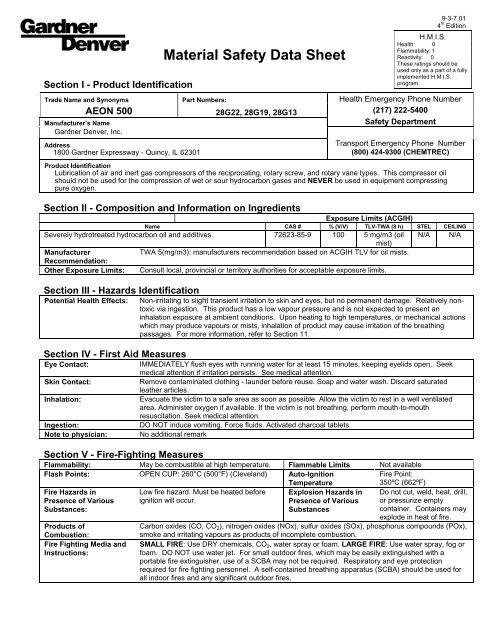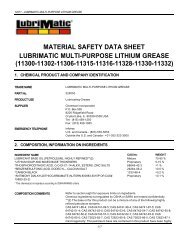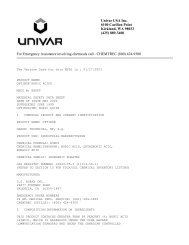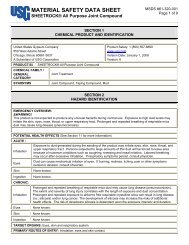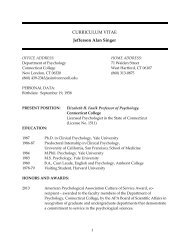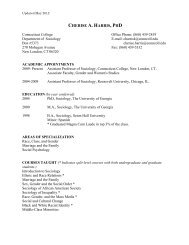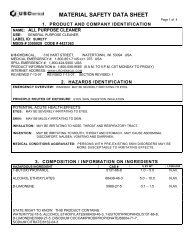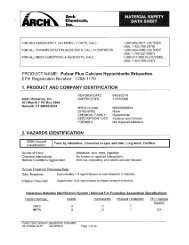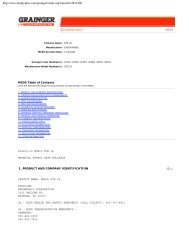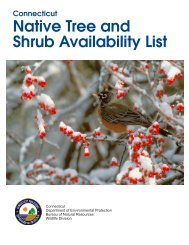Aeon 500 Reciprocating Compressor Oil
Aeon 500 Reciprocating Compressor Oil
Aeon 500 Reciprocating Compressor Oil
Create successful ePaper yourself
Turn your PDF publications into a flip-book with our unique Google optimized e-Paper software.
Section I - Product IdentificationMaterial Safety Data Sheet9-3-7.014 th EditionH.M.I.S.Health: 0Flammability: 1Reactivity: 0These ratings should beused only as a part of a fullyimplemented H.M.I.S.program.Trade Name and Synonyms Part Numbers: Health Emergency Phone NumberManufacturer’s NameGardner Denver, Inc.AEON <strong>500</strong> 28G22, 28G19, 28G13 (217) 222-5400Address1800 Gardner Expressway - Quincy, IL 62301Safety DepartmentTransport Emergency Phone Number(800) 424-9300 (CHEMTREC)Product IdentificationLubrication of air and inert gas compressors of the reciprocating, rotary screw, and rotary vane types. This compressor oilshould not be used for the compression of wet or sour hydrocarbon gases and NEVER be used in equipment compressingpure oxygen.Section II - Composition and Information on IngredientsExposure Limits (ACGIH)Name CAS # % (V/V) TLV-TWA (8 h) STEL CEILINGSeverely hydrotreated hydrocarbon oil and additives. 72623-85-9 100 5 mg/m3 (oil N/A N/Amist)ManufacturerTWA 5(mg/m3): manufacturers recommendation based on ACGIH TLV for oil mists.Recommendation:Other Exposure Limits: Consult local, provincial or territory authorities for acceptable exposure limits.Section III - Hazards IdentificationPotential Health Effects:Section IV - First Aid MeasuresEye Contact:Skin Contact:Inhalation:Ingestion:Note to physician:Section V - Fire-Fighting MeasuresNon-irritating to slight transient irritation to skin and eyes, but no permanent damage. Relatively nontoxicvia ingestion. This product has a low vapour pressure and is not expected to present aninhalation exposure at ambient conditions. Upon heating to high temperatures, or mechanical actionswhich may produce vapours or mists, inhalation of product may cause irritation of the breathingpassages. For more information, refer to Section 11.IMMEDIATELY flush eyes with running water for at least 15 minutes, keeping eyelids open. Seekmedical attention if irritation persists. See medical attention.Remove contaminated clothing - launder before reuse. Soap and water wash. Discard saturatedleather articles.Evacuate the victim to a safe area as soon as possible. Allow the victim to rest in a well ventilatedarea. Administer oxygen if available. If the victim is not breathing, perform mouth-to-mouthresuscitation. Seek medical attention.DO NOT induce vomiting. Force fluids. Activated charcoal tablets.No additional remarkFlammability: May be combustible at high temperature. Flammable Limits Not availableFlash Points: OPEN CUP: 260°C (<strong>500</strong>°F) (Cleveland) Auto-IgnitionTemperatureFire Point:350ºC (662ºF)Fire Hazards inPresence of VariousSubstances:Low fire hazard. Must be heated beforeignition will occur.Explosion Hazards inPresence of VariousSubstancesDo not cut, weld, heat, drill,or pressurize emptycontainer. Containers mayexplode in heat of fire.Products ofCombustion:Carbon oxides (CO, CO 2 ), nitrogen oxides (NOx), sulfur oxides (SOx), phosphorus compounds (POx),smoke and irritating vapours as products of incomplete combustion.Fire Fighting Media andInstructions:SMALL FIRE: Use DRY chemicals, CO 2 , water spray or foam. LARGE FIRE: Use water spray, fog orfoam. DO NOT use water jet. For small outdoor fires, which may be easily extinguished with aportable fire extinguisher, use of a SCBA may not be required. Respiratory and eye protectionrequired for fire fighting personnel. A self-contained breathing apparatus (SCBA) should be used forall indoor fires and any significant outdoor fires.
Section VI - Accidental Release MeasuresMaterial Release orSpill:Section VII - Handling and StorageHandling:Storage:9-3-7.014 th EditionNAERG98, GUIDE 171, Substances (low to moderate hazard). ELIMINATE ALL IGNITIONSOURCES. Avoid contact. Stop leak if without risk. Contain spill. Absorb with inert absorbents, dryclay, or diatomaceous earth. Avoid inhaling dust of diatomaceous earth for it may contain silica invery fine particle size, making this a potential respiratory hazard. Place used absorbent in closedmetal containers for later disposal or burn absorbent in a suitable combustion chamber. DO NOTFLUSH TO SEWERS, STREAMS, OR OTHER BODIES OF WATER. Check with applicablejurisdiction for specific disposal requirements of spilled material and empty containers. Notify theappropriate authorities immediately.Avoid inhalation and skin contact especially when handling used oil. Keep away from sources ofignition. DO NOT reuse empty containers without commercial cleaning or reconditioning. Practicegood personal hygiene. Wash hands after handling and before eating. Launder work clothesfrequently. Discard saturated leather goods.Combustible materials should be stored away from extreme heat and away from strong oxidizingagents. Store in cool, well-ventilated area.Section VIII - Exposure Controls/Personal ProtectionEngineering Controls:Personal Protection:EyesBodyRespiratoryHandsFeetGood general ventilation should be sufficient to control airborne levels. Local exhaust, if necessary, tomaintain allowable limits.Safety GlassesLong sleeved clothing to minimize skin contact.Where concentrations in air may exceed the occupational exposure limits given in Section 2 (andthose applicable to your area) and where engineering work practices or other means of exposurereduction are not adequate, NIOSH approved respirators may be necessary to prevent overexposureby inhalation.For casual contact, PVC gloves are suitable. For direct contact for more than 2 hours, NEOPRENE orNITRILE gloves are recommended.Wear appropriate footwear to prevent product from coming in contact with feet and skin.Section IX - Physical and Chemical PropertiesPhysical State and Appearance: Liquid (Viscous Liquid) Viscosity:90-110 cST @ 40ºC (104ºF).11.2 cST @ 100ºC (212ºF). VI-97Color: Pale Yellow Pour Point: -18Odor: Hydrocarbon (Slight) Softening Point: Not applicableOdor Threshold: Not Available Dropping Point: Not applicableBoiling Point: 400°C (752°F) Penetration: Not applicableSpecific Gravity: 0.87 (Water = 1) Ionicity (In water): Insoluble in waterDensity: 0.871 kg/L @ 15ºC (59ºF) Dispersion Properties: Not availableVapor Density: Not available Solubility: Insoluble in waterVapor Pressure: 0.0075 mm of Hg (@20°C) Volatility: Non-volatileSection X - Stability and ReactivityCorrosivity:Stability:IncompatibleSubstances/ Conditionsto Avoid:Not applicableThe product is stable under normalhandling and storage conditions.Highly reactive with oxidizing agents,acids.HazardousPolymerization:DecompositionProducts:Will not occur under normal workingconditions.May release COx, NOx, SIOx,methacrylate monomers, POx, smokeand irritating vapours when heated todecomposition.Section XI - Toxicological InformationRoutes of Entry:Acute Lethality:Chronic or other effects:Dermal RouteInhalation RouteOral RouteEye Irritation/InflammationInhalation and Ingestion, Skin Contact, Eye ContactBased on toxicity of components.Acute oral toxicity (LD50): ><strong>500</strong>0 mg/kg (rat).Acute dermal toxicity (LD50): >2000 mg/kg (rabbit).Prolonged or repeated contact may cause skin irritation characterized by dermatitis or oilacne.Negligible breathing hazard at normal temperatures (up to 38ºC) or recommendedblending temperatures. Elevated temperatures or mechanical action may form vapours,mists, or fumes. Inhalation of oil mists or vapours from hot oil may cause irritation of theupper respiratory tract.Low toxicity; has laxative effect.Repeated or prolonged contact may cause transient irritation, but no permanent damage.
9-3-7.014 th EditionImmunotoxicitySkin SensitizationRespiratory Tract SensationMutagenicReproductive ToxicityTeratogenicity/EmbryotoxicityCarcinogenicity (ACGIH)Carcinogenicity (IARC)Carcinogenicity (NTP)Carcinogenicity (IRIS)Carcinogenicity (OSHA)Other Considerations:Not availableThis product is not expected to be a skin sensitizer based on the available data and theknown hazards of the components.This product is not expected to be a respiratory tract sensitizer based on the availabledata and the known hazards of the components.Based on actual test results of base oils and results of similar products, severelyhydrotreated base oils give negative results when tested for: (a) Salmonella TyphimuriumTA98 using the Modified Ames Assay for Petroleum Product; (b) Salmonella-Escherichiacoll/Mammalian-Microroma Reverse Mutation Assay (Ames test) with a ConfirmatoryAssay; (c) Structural Chromosomal Aberrations in Chinese Hamster Ovary (CHO) Cells.This product is not considered to be a reproductive hazard, based on the available dataand the known hazards of the components.This product is not considered to be a taratogen or an embryotoxin, based on theavailable data and the known hazards of the components.This product is not known to contain any chemicals at reportable quantities that are listedas A1 or A2 carcinogens by ACGIH.This product is not known to contain any chemicals at reportable quantities that are listedas 1, 2A or 2B carcinogens by IARC.This product is not known to contain any chemicals at reportable quantities that are listedas carcinogens by NTP.Not availableThis product is not known to contain any chemicals at reportable quantities that are listedcarcinogens by OSHA.No additional remarkSection XII - Ecological InformationEnvironmental Fate: Not available Persistence/ Biaccumulation No Studies were foundPotential:BOD5 and COD: Not available Products of Biodegration: Not availableAdditional Remarks: No additional remarkSection XIII - Disposal ConsiderationsWaste Disposal:Consult your local or regional authorities. Preferred waste management priorities are (1) recycle or reprocess;(2) incineration with energy recovery; (3) disposal at licensed waste disposal facility. Ensure that disposal orreprocessing is in compliance with government requirements and local disposal regulations.Section XIV - Transport InformationTDG Classification: Not controlled under TDG (Canada) Special Provisions for Transport: No additional remarkSection XV - Regulatory InformationOther Regulations:CANADIAN ENVIRONMENTAL PROTECTION ACT (CEPA): This product is acceptable foruse under the provisions of WHMIS-CPR. All components of this formulation are listed on the CEPA-DSL (Domestic Substances List). EPA : All components of this formulation are listed on the US EPA-TSCA inventory.This product has been classified in accordance with the hazard criteria of the Controlled ProductsRegulations (CPR) and the MSDS contains all of the information required by the CPR. Please contactProduct Safety for more information.WHMIS (Canada): Not a controlled product under Canadian WHMIS Hazard Criteria; as specified in Controlled Product Regulation.DSD/DPD (Europe): Not classified under the Dangerous Substances or Dangerous Preparations Directives.HMIS (U.S.A.) 0 Health Hazard NFPA (U.S.A.)Fire HazardRating 0 Insignificant1 Fire Hazard1 SlightHealthReactivity0 Reactivity2 Moderateb Personal ProtectionSpecific Hazard3 High4 Extreme
Section XVI - Other Information9-3-7.014 th EditionReferences:Available upon requestGlossary:HCS - Hazardous Communication SystemACGIH - American Conference of Governmental IndustrialHMIS - Hazardous Material Information SystemHygienistsASTM - American Society for Testing and MaterialsIARC - International Agency for Research on CancerADR - Agreement on Dangerous Goods by Road (Europe)IRIS - Integrated Risk Information SystemBOD5 - Biological Oxygen Demand in 5 Days LD50/LC50 - Lethal Dose/Concentration Kill 50%CAN/CGA B149.2 - Propane Installation CodeLDLo/LCLo - Lowest Published Lethal Dose/ConcentrationCAS - Chemical Abstract ServicesNAERG=96 - North American Emergency Response GuideBook (1996)CEPA - Canadian Environmental Protection ActNFPA - National Fire Prevention AssociationCERCLA - Comprehensive Environmental Response,Compensation andNIOSH - National Institute for Occupational Safety & HealthNPRI - National Pollutant Release InventoryLiability ActCFR - Code of Federal RegulationsNTP - National Toxicology ProgramCHIP - Chemical Hazard Information and Packaging Approved OSHA - Occupational Safety & Health AdministrationSupply ListCOD - Chemical Oxygen DemandPEL - Permissible Exposure LimitCPR - Controlled Products RegulationRCRA - Resource Conservation and Recovery ActDOT - Department of Transportation (U.S.A.)SARA - Superfund Amendments and Reorganization ActDSCL - Dangerous Substances Classification and Labeling SD - Single Dose(Europe)DSD/DPD - Dangerous Substance or Dangerous PreparationsDirectives(Europe)DSL - Domestic Substance ListEEC/EU - European Economic Community/European UnionEINECS - European Inventory of Existing Commercial ChemicalSubstancesEPCRA - Emergency Planning and Community Right-To-Know ActFDA - Food and Drug AdministrationFIFRA - Federal Insecticide, Fungicide, and Rodenticide ActSTEL - Short Term Exposure Limit (15 minutes)TDG - Transportation Dangerous Goods (Canada)TDLo/TCLo - Lowest Published Toxic Dose/ConcentrationTLm - Median Tolerance LimitTLV-TWA - Threshold Limit Value - Time Weighted AverageTSCA - Toxic Substances Control ActUSEPA - United States Environmental Protection AgencyUSP - United States PharmacopoeiaWHMIS - Workplace Hazardous Material Information SystemTo the best of our knowledge, the information contained herein is accurate. However, neither the above named supplier nor any of itssubsidiaries assumes any liability whatsoever for the accuracy or completeness of the information contained herein. Finaldetermination of suitability of any material is the sole responsibility of the user. All materials may present unknown hazards andshould be used with caution. Although certain hazards are described herein, we cannot guarantee that these are the only hazards thatexist.Prepared by the Product Specialist, AftermarketJanuary 2007


